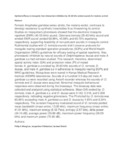| dc.description.abstract | Female Anopheles gambiae sensu stricto, the malaria vector, continues to develop resistance to synthetic insecticides thus threatening its control. Studies on mosquitoe's phonotaxis showed that the electronic mosquito repellent (EMR) (40-55 kHz) sound, Odorrana tormota (35-60 kHz) sound and winded-EMR sound yielded 68.99%, 45.88% and 60.70% repellency respectively, supporting feasibility of non-pollutant sounds in mosquito control. Rudimental studies with O. tormota sounds didn’t observe protocols for mosquito rearing standard operation procedures (SOPs) and World Health Organisation (WHO) guidelines for efficacy testing of spatial repellents. Also, phonotactic inhibition by natural sounds of Delphinapterus leucas and male A. gambiae s.s had not been studied. This research, therefore, determined spatial activity index (SAI) and protection index (PI) of mated female A. gambiae s.s evoked by 35-60 kHz sounds of O. tormota, D. leucas, and male A. gambiae s.s in adherence to mosquito rearing SOPs and WHO guidelines. Mosquitoes were reared in Kenya Medical Research Institute (KEMRI) laboratories. Sounds of a hundred 3-5-day-old male A. gambiae s.s were recorded using Avisoft recorder whereas the sounds of O. tormota and D. leucas were acquired. Abnormal mosquito behavioural responses were observed during the bioassays. The bioassay data was collected and analyzed using statistical softwares. Mean SAI evoked by O. tormota, male A. gambiae s.s, and D. leucas were 0.142, 0.318, and 0.206 respectively, indicating negative phonotaxis. The PI elicited by O. tormota was 80.06% exceeding male A. gambiae s.s and D. leucas by 1.65% and 8.24% respectively. The constant frequency modulated sound of O. tormota yielded mean bandwidth (mean entire; 13.95 kHz), maximum frequency (mean entire; 41.61 kHz), maximum energy (8.02 Pa2s), entropy (2.87 bits), delta power (24.10 dB), average power (55.60 dB), maximum power frequency (38.09 kHz) and maximum power (75.90 dB). | en_US |
| dc.subject | Optimal, efficacy, mosquito-host, interaction, inhibition, 35-60 kHz, animal, sounds, malaria, control | en_US |

